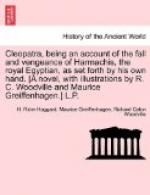It may be mentioned that so late as the reign of Ptolemy Epiphanes, pretenders of native blood, one of whom was named Harmachis, are known to have advanced their claims to the throne of Egypt. Moreover, there was a book of prophecy current among the priesthood which declared that after the nations of the Greeks the God Harsefi would create the “chief who is to come.” It will therefore be seen that, although it lacks historical confirmation, the story of the great plot formed to stamp out the dynasty of the Macedonian Lagidae and place Harmachis on the throne is not in itself improbable. Indeed, it is possible that many such plots were entered into by Egyptian patriots during the long ages of their country’s bondage. But ancient history tells us little of the abortive struggles of a fallen race.
The Chant of Isis and the Song of Cleopatra, which appear in these pages, are done into verse from the writer’s prose by Mr. Andrew Lang, and the dirge sung by Charmion is translated by the same hand from the Greek of the Syrian Meleager.
CLEOPATRA
INTRODUCTION
In the recesses of the desolate Libyan mountains that lie behind the temple and city of Abydus, the supposed burying place of the holy Osiris, a tomb was recently discovered, among the contents of which were the papyrus rolls whereupon this history is written. The tomb itself is spacious, but otherwise remarkable only for the depth of the shaft which descends vertically from the rock-hewn cave, that once served as the mortuary chapel for the friends and relatives of the departed, to the coffin-chamber beneath. This shaft is no less than eighty-nine feet in depth. The chamber at its foot was found to contain three coffins only, though it is large enough for many more. Two of these, which in all probability inclosed the bodies of the High Priest, Amenemhat, and of his wife, father and mother of Harmachis, the hero of this history, the shameless Arabs who discovered them there and then broke up.
The Arabs broke the bodies up. With unhallowed hands they tore the holy Amenemhat and the frame of her who had, as it is written, been filled with the spirit of the Hathors—tore them limb from limb, searching for treasure amidst their bones—perhaps, as is their custom, selling the very bones for a few piastres to the last ignorant tourist who came their way, seeking what he might destroy. For in Egypt the unhappy, the living find their bread in the tombs of the great men who were before them.
But as it chanced, some little while afterwards, one who is known to this writer, and a doctor by profession, passed up the Nile to Abydus, and became acquainted with the men who had done this thing. They revealed to him the secret of the place, telling him that one coffin yet remained entombed. It seemed to be the coffin of a poor person, they said, and therefore, being pressed for time, they had left it unviolated. Moved by curiosity to explore the recesses of a tomb as yet unprofaned by tourists, my friend bribed the Arabs to show it to him. What ensued I will give in his own words, exactly as he wrote it to me:




